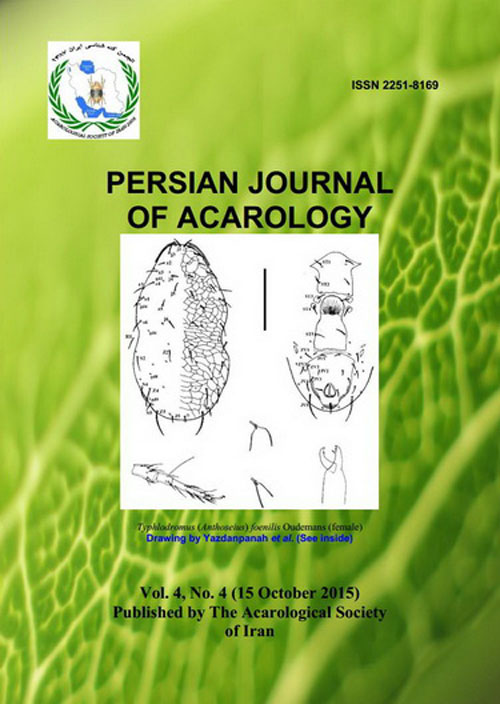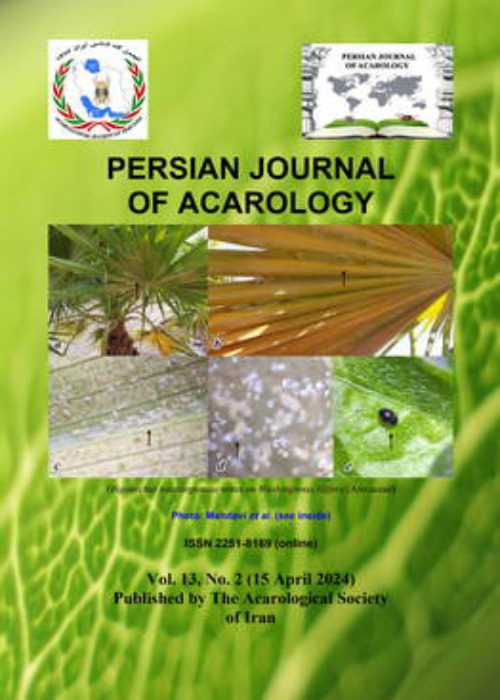فهرست مطالب

Persian Journal of Acarology
Volume:4 Issue: 3, Summer 2015
- تاریخ انتشار: 1394/07/26
- تعداد عناوین: 7
-
-
Page 249A total of 9 pairs of sigilla on the podonotum (all in pair except single saI' but counted as a pair: saI', saI", saII, saIII, saIV, saV, saVI, sp, and ss) and 7 pairs on the opisthonotum (saIX, saX, saXI, saXII, saXIII, saXIV, and sg) along with setae, solenostomes and lyrifissures in 9 females of 4 species and 3 males of 2 species of Paraphytoseius [cracentis (Corpuz and Rimando, 1966) = 3 non-paratype females; multidentatus Swirski and Shechter, 1961 = 2 paratype females; orientalis (Narayanan, Kaur and Ghai, 1960) = 2 non-type females and 1 non-type male; and santurcensis De Leon, 1965 = 2 paratype females and 2 paratype males] are compared and given in several voucher photos. These are similar in location to those described by Athias-Henriot (1975). They are very similar in all 4 species, with little difference in female and male, and thus appear to be of no taxonomic value in differentiating these species. Problems with sigilla, especially, near and posterior to j1-j1 and around the solenostome gd5, are discussed. It is established that sigilla on the opisthonotum (7 pairs: saIX, saX, saXI, saXII, saXIII, saXIV and sg) are well differentiated and clearly seen than those on the podonotum in these species and may be used for study in other species of Phytoseiidae. A hypothetical model of P. cracentis in a line drawing indicating all sigilla in relation to the dorsal setae, solenostomes, and lyrifissures is included.Keywords: Adenotaxy, gd5, Paraphytoseius, poroidotaxy, sigilla, sigillotaxy, voucher photos
-
Page 277The mite Acarophenax sphindi Rahiminejad & Hajiqanbar sp. nov. (Acari: Heterostigmata) collected under head of the host beetle, Sphindus sp. (Coleoptera: Sphindidae) is described and illustrated from Oak forests of Golestan province, northern Iran. It is first record of the beetle family Sphindidae (Col.: Cucujoidea) as an acarophenacid host. Moreover, host range of the genus is reviewed and a key to world species of the genus Acarophenax Newstead & Duvall, 1918, is provided.Keywords: Cucujoidea, Gorgan city, mite, parasitoid, Prostigmata
-
Page 287Stigmaeus creber Barilo, 1986, and Stigmaeus hashtrudiensis Bagheri & Maleki, 2014, are reported from Turkey for the first time and re-described.Keywords: Acari, Stigmaeidae, Stigmaeus creber, Stigmaeus hashtrudiensis, new record, Turkey
-
Page 297A new species, Phyllocoptruta neemae sp. nov. of the family Eriophyidae was found on both surface of leaves of Azadirachta indica Juss (Meliaceae), and described and illustrated from specimens collected at Kalyani, West Bengal, India. This is the third eriophyoid mite species described from A. indica in India. The key of the Indian Phyllocoptruta species was given.Keywords: Eriophyidae, taxonomy, eriophyid mite, neem, Phyllocoptinae
-
Page 305The present study was conducted to measure the population dynamics and seasonal variation of Panonychus ulmi (Koch) on four commercial mulberry varieties viz. Goshoerami, KNG, Tr10 and Ichinose in Kashmir valley. Observations were made fortnightly on the mite density per leaf by selecting five plants from each of four accessions and five branches from each plant with the help of 20x hand lens. Influence of weather parameters on the population build-up and seasonal variations were quantified. The population of P. ulmi was highly affected by weather parameters and was very low during spring and reached maximum in the midst of summer in the varieties selected. Tr10 and Goshoerami varieties were found the most susceptible with the highest population number; however, other varieties showed little resistance. Correlation and multiple regression analysis showed significant relation between P. ulmi population build-up and weather parameters. It can be concluded, that P. ulmi is a serious pest of mulberry plants and can cause significant loss to mulberry foliage. Temperature and relative humidity are the key factors determining rapid multiplication of this mite in mulberry ecosystem.Keywords: European red spider mite, population, Morus spp., abundance, weather parameters
-
Page 319Recent reports indicate that female prey species may increase the time to oviposition in order to prevent egg predation. The generality of this behavior is unknown especially among herbivorous mites. We used females of two forms of Tetranychus urticae, red and green forms, to study whether they retain eggs in response to exposure to the predatory mites Phytoseiulus persimilis and Amblyseius swirskii. Females were tested in two situations: 1) receiving cues related to predator-prey interaction; 2) perceiving the direct presence of predator. None of the treatments induced the T. urticae forms to retain eggs. The egg development time of the green form was significantly shorter than that of the red form after receiving cues related to P. persimilis-prey interactions. The egg development time of the forms did not show significant difference in the direct presence of each of the predator species. The probability of hatching plasticity in T. urticae is discussed.Keywords: Egg retention, hatching plasticity, oviposition, Phytoseiidae, spider mites
-
Page 329The alfalfa stem nematode, Ditylenchus dipsaci (Kühn) causes substantial damage to alfalfa crops in Iran every year. Rhizoglyphus robini Claparède is a polyphagous pest of bulbs, corms and tubers, but can be beneficial in some situations. This study examined the effect of R. robini as a predator of D. dipsaci in greenhouse conditions. Pot experiments showed that R. robini caused high mortality of D. dipsaci. The effect of R. robini density on mortality of D. dipsaci was mathematically modeled using the response surface methodology (RSM). These observations suggest that R. robini may contribute to regulate populations of this nematode.Keywords: Rhizoglyphus robini, biological control, Ditylenchus dipsaci, alfalfa stem nematode, predator


